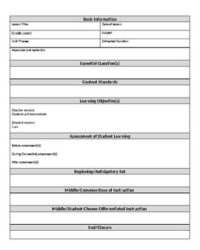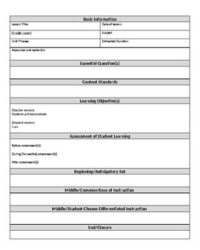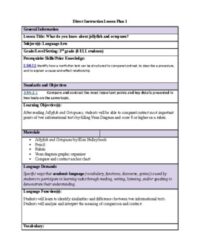Navigating the edTPA can feel like deciphering an ancient language, especially when it comes to crafting a world language lesson plan that meets all the stringent requirements. You’re not just planning a lesson; you’re meticulously documenting your pedagogical prowess, your understanding of student learning, and your ability to adapt. It’s a comprehensive performance-based assessment designed to evaluate your readiness to teach, and getting that lesson plan right is foundational to success.
Many aspiring world language teachers find themselves searching for the perfect framework, a guide that simplifies the complex demands into actionable steps. The good news is that while there isn’t a single, universally mandated edTPA template, understanding the core components and aligning them with your instruction can make all the difference. This article aims to demystify the process and highlight what goes into an effective edTPA world language lesson plan template.
Deconstructing the Core Components of Your World Language edTPA
The edTPA for World Languages is incredibly specific, focusing on how you facilitate communication, connect language to culture, and foster student learning. Your lesson plans, therefore, aren’t just outlines of activities; they are evidence of your pedagogical thinking. They need to clearly articulate your learning objectives, how you’ll assess student progress, and how you’ll differentiate instruction to meet diverse needs. It’s about showing a coherent learning segment, typically 3-5 days of instruction, all tied together by a central focus. Every decision you make, from the choice of vocabulary to the type of authentic resource, must be intentional and aligned with your learning goals.
One of the most critical aspects is the integration of the three modes of communication: Interpretive, Interpersonal, and Presentational. Your lessons must provide opportunities for students to engage with all three, demonstrating their ability to understand, interact, and produce language. This isn’t just about listing activities; it’s about explaining *how* each activity promotes specific communicative skills and *why* it’s appropriate for your students. Furthermore, the cultural connection isn’t an add-on; it’s woven into the fabric of your instruction, enriching the language learning experience and providing context for communication.
Designing for Academic Language
A significant focus of the edTPA is academic language, which encompasses the language demands of the learning task. For world languages, this means identifying the key vocabulary, language functions, discourse, and syntax students will need to understand and use to participate in the learning segment. You need to explicitly plan how you will teach, support, and assess these academic language demands. It’s not enough to simply use the target language; you must teach students how to *think* and *talk* about the target language and the content within it. Your lesson plan should detail the strategies you will employ to scaffold this complex aspect of language acquisition, ensuring all students, regardless of their proficiency level, have access to and can produce the required academic language.
Backward Design and Assessment Integration
Effective lesson planning for edTPA often employs a backward design approach. This means starting with your desired learning outcomes and the evidence you’ll collect to show students have met them. Assessments in edTPA are not just quizzes; they are opportunities for students to demonstrate their communicative proficiency in meaningful ways. You need to design both formal and informal assessments that provide clear evidence of student learning across the communication modes and academic language demands. Then, and only then, do you plan the instructional activities that will lead students to successfully meet those outcomes and perform well on the assessments. This holistic approach ensures every part of your edTPA world language lesson plan template works in concert, showing a clear path from learning objectives to student achievement.
Practical Tips for Crafting Your Lesson Plans
When you’re immersed in the edTPA process, it’s easy to get overwhelmed by the sheer volume of documentation required. But think of your lesson plans as your script for a successful performance. They are your blueprint, your strategy, and your evidence all rolled into one. While there isn’t a single “official” edTPA world language lesson plan template, focusing on clarity, coherence, and alignment will serve you well. Remember that the evaluators are looking for your ability to connect theory to practice, to show how your decisions directly impact student learning and development in the target language.
One of the biggest pieces of advice we can offer is to be incredibly specific. Avoid vague terms and instead, articulate precisely what students will *do* and *say* to demonstrate their learning. How will you facilitate interaction? What specific questions will you ask to check for understanding? How will students use the target language in a meaningful, communicative way? These details are what elevate a standard lesson plan into an edTPA-ready document. Furthermore, consider how each activity contributes to the overarching learning segment goals and how it helps students build upon prior knowledge.
Consider these key elements as you develop your lesson plans:
- Clearly defined learning objectives aligned with state or national standards and the three modes of communication.
- Specific language demands (vocabulary, functions, discourse, syntax) and strategies for teaching them.
- Differentiated instruction plans that address the needs of diverse learners, including those with special needs or varying proficiency levels.
- Meaningful and varied assessment strategies that measure student learning in all three communication modes.
- Explicit connections to culture and real-world contexts, moving beyond mere facts to deeper understandings.
- Opportunities for student choice and voice, fostering engagement and autonomy.
Ultimately, your lesson plans are your narrative of teaching and learning. They should tell a compelling story of how you will guide your students to develop communicative competence and cultural understanding. Every choice, every activity, every assessment should build towards this narrative, demonstrating your readiness to step into the classroom as a confident and competent world language educator.
Approaching your edTPA with a clear understanding of what’s expected in your lesson plans can transform what seems like a daunting task into a manageable and even insightful experience. It’s an opportunity to showcase your passion for language education and your ability to design instruction that truly resonates with learners. By meticulously crafting each component of your plans, you’re not just checking boxes; you’re building a strong foundation for your future teaching career, preparing yourself to inspire the next generation of global citizens.


